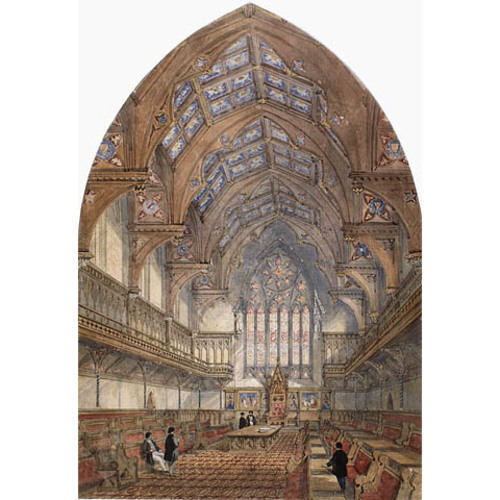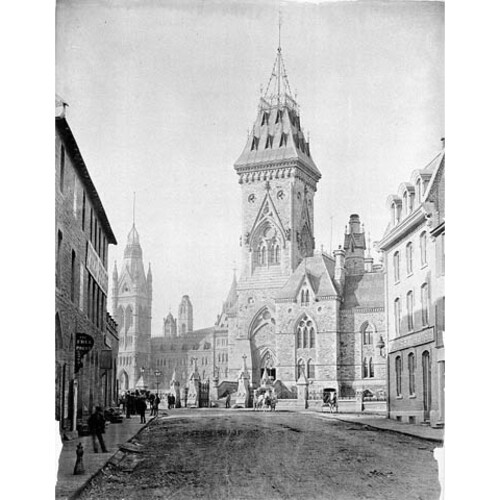LAVER, AUGUSTUS, architect; b. 19 or 20 Sept. 1834 in Folkestone, England, only son of George Laver, a leading solicitor, and Mary Ann —; m. 9 June 1859 Elizabeth Fox in Dover, England, and they had twin sons and a daughter; d. 27 March 1898 in Alameda, Calif.
After a primary education that was private for the most part, Augustus Laver was apprenticed for four years to the architect Thomas Hellyer of Ryde, Isle of Wight. He then worked in various London architectural offices until he was qualified to practise, when he joined the Post Office Department as a staff architect for about two years. In 1856, a year before leaving for the United States, he became a member of the Royal Institute of British Architects, forming a connection that he cherished throughout his life.
Laver did not remain long in the United States. In 1858 he moved to Ottawa, where he soon formed a partnership with a more experienced architect, Thomas Stent. Presumably both men were attracted to Ottawa because it had been selected as the permanent capital of the Canadas early that year and a building boom was anticipated. To promote the capital and their own practice, Stent and Laver published a bird’s-eye view of the city. They also produced a lithograph of a perspective drawing for their first major commission, a large villa at Rockcliffe (Ottawa) designed for Dr Robert Hunter, which was never built.
In May 1859 proposals were invited for Ottawa’s intended parliamentary and departmental buildings and governor general’s residence. Since Laver was absent from Ottawa in connection with his wedding in England for much of the time before the competition closed on 1 August, the greater part of the work in preparing their submission fell upon Stent. The first premium for the design of the departmental buildings, now known as the east and west blocks, was awarded to their proposal in the fashionable civil Gothic style, while their entry in the same style for the parliamentary building secured second prize. The winner in the latter case was the design, also in civil Gothic, by the Toronto partnership of Thomas Fuller and Chilion Jones. The east and west blocks and the Fuller and Jones library, which was spared in the centre block fire of 1916, comprise the surviving elements of the original complex.
Contracts for construction of the departmental buildings were let late in 1859 and the foundations were begun the following spring. By 1861, however, the work was behind schedule and it had become apparent that the costs had been seriously underestimated. Building was halted at the end of that season while a special commission made an inquiry. During the hearings, Stent was the spokesman for the partnership, a role that underlined his greater involvement in the project. The commission’s report in March 1863 found some faults in the architects’ discharge of their duties but recommended that they be re-employed. The government, however, dismissed all the architects except Thomas Fuller, who, with Charles Baillairgé*, was appointed associate architect for the completion of the work under the supervision of Frederick Preston Rubidge, the senior architect of the Department of Public Works.
Before dissolving their partnership in January 1865, Stent and Laver prepared designs for several other buildings in the civil Gothic style: among these were the Finlay Asylum (1860) and the Canada Military Asylum (1862) in Quebec as well as a proposal for the houses of parliament and public offices for New South Wales in Sydney (1860), which won the second premium. For commercial and industrial buildings, however, Stent and Laver seem to have preferred an Italianate style, as seen in two buildings erected in Ottawa in 1864: a store on Sparks Street they designed with a robust façade for Garland, Mutchmor and Company and the more restrained Desbarats Block for the queen’s printer.
Practising on his own during 1865–66, Laver was the architect for extensive alterations and additions to Ottawa’s popular Russell Hotel. As well, he submitted an entry in the 1866 competition to design the New York State capitol at Albany and was awarded one of the premiums. The following August, Laver participated with Thomas Fuller, who had moved to Albany, and Arthur Delavan Gilman in preparing a revised design. Late that year he too moved to Albany where he and Fuller were in partnership. Construction of the capitol was punctuated with controversy and neither partner was involved in the completion of the project.
In 1871 Fuller and Laver won the competition to design the new city hall and law courts for San Francisco. Laver moved there that October to assume responsibility for the project. From the time construction began until the still-unfinished building was destroyed in the fire following the 1906 earthquake, it, like the capitol project in Albany, was plagued with difficulties. Notwithstanding the annoyance and embarrassment of the city hall controversy, Laver went on to develop a large and successful practice in the San Francisco Bay area before his death in March 1898 caused by “complication of heart and lung troubles.”
Augustus Laver seems to have been most successful with private clients and their commissions, particularly in California, although, through his alliances with such talented designers as Stent and Fuller, he was able to participate in three of the most celebrated public buildings in North America. He enjoyed the confidence of his profession as well as his partners, having, in addition to his involvement with the Royal Institute of British Architects, been president of the Pacific Coast Association of Architects and a fellow of the American Institute of Architects.
A comprehensive list of Laver’s architectural works, prepared by Stephen A. Otto, is available in the DCB’s files.
“Architecture in Ottawa,” Building News (London), 5 (1859): 453. Can., Prov. of, Commission appointed to inquire into matters connected with the public buildings at Ottawa, Report (Quebec, 1863). Argus (Alameda, Calif.), 29 March 1898. Brockville Recorder, 25 Nov. 1858, 13 Jan. 1859. Encinal (Alameda), 28 March 1898. Examiner (San Francisco), 28 March 1898. Ottawa Citizen, 25 June 1861, 14 June 1862, 2 Oct. 1863. Ottawa Tribune, 11 June 1859, 4 Oct. 1861. Times (London), 15 June 1859. Union (Ottawa), 28 March 1863, 13 Jan. 1865. Alonzo Phelps, Contemporary biography of California’s representative men, with contributions from distinguished scholars and scientists (San Francisco, 1882).
Cite This Article
Stephen A. Otto, “LAVER, AUGUSTUS,” in Dictionary of Canadian Biography, vol. 12, University of Toronto/Université Laval, 2003–, accessed January 20, 2026, https://www.biographi.ca/en/bio/laver_augustus_12E.html.
The citation above shows the format for footnotes and endnotes according to the Chicago manual of style (16th edition). Information to be used in other citation formats:
| Permalink: | https://www.biographi.ca/en/bio/laver_augustus_12E.html |
| Author of Article: | Stephen A. Otto |
| Title of Article: | LAVER, AUGUSTUS |
| Publication Name: | Dictionary of Canadian Biography, vol. 12 |
| Publisher: | University of Toronto/Université Laval |
| Year of publication: | 1990 |
| Year of revision: | 1990 |
| Access Date: | January 20, 2026 |




